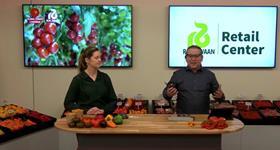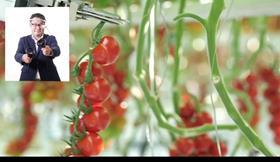


Robotics, yield forecasting, data use and breeding were just some of the subjects touched upon by expert speakers at this year's Global Tomato Congress.
The event, which attracted over 2,000 attendees, included an in-depth look at some of the industry's most exciting technological innovations.
Robotics
Edwin Vanlaerhoven of Certhon and Haruhiko Kato of Denso looked at the potential benefits the robotisation of harvesting could bring to the tomato business.
Vanlaerhoven said that Denso, an automated technology specialist, was utilising Certhon's experience in horticulture to help bring the industry to the next level in terms of robotisation.
'We see a big demand worldwide for locally grown fresh produce,' he confirmed, 'but on the other hand we see a big shortage of labour. We want to simplify growing and help our customers even more, and for this you need better technology. We are going to further develop Denso's robots, and make them more useful for horticulture.'
The first step, he noted, was to develop robots for harvesting tomatoes inside greenhouses, while also working on new growing systems that those robots would be integrated with.
Kato, director of the food value chain business development division at Denso, noted that there were currently two main issues with developing robotics for horticulture – an environmental one, given agriculture takes place under many different conditions, and an issue over expectations and the fact robots will be expected to perform in the same way humans do.
“When humans harvest, they will also be checking the growth condition of the crop, or looking for signs of diseases,” he explained. “When robots take over the operations, they will not only be handling these tasks, but also communicating with other workers.
“This is a big challenge for us, but if we can realise this we are sure it will innovate the agricultural world.”
Breeding
Haoyang Duo of Syngenta discussed the future of tomato breeding, highlighting how the group’s new Tomato Vision centre – opened last year – brought together science and marketing to help cater for it customers.
“We want to create tomatoes for everyone, for today and tomorrow, and Tomato Vision is one of the places that we put this promise into action,” she said. “For example, we have a virtual assistant tool called Hololens which showcases plants in our greenhouses virtually to customers who cannot visit physically.
Another important piece of technology utilised by Syngenta is big data, Duo said.
“We collect things like yield, fruit weight, acid or sugar content, while also picking up the genetic data of the tomatoes,” she added. “By combining data from the field and from the laboratory, we are able to make genomic selections and better predictions in breeding. That will increase efficiency in the breeding process.'
Data
The subject of data was the focal point for New Zealand-based WayBeyond, with the group’s Sophie Stanley speaking on how to make better use of data to optimise tomato supply chains.
She questioned whether tomato growers were optimising the use of the data that they were collecting from their systems. “Every day in your operations you’re collecting thousands of data points from all the solutions that you use, and your plants are whispering secrets to you, but are you really getting the best out of what those plants are telling you?” she wondered.
Stanley pointed to three key areas when it came to the optimisation of data – open platforms, how these create opportunities through the use of things like AI, and how these combine to build towards the future in areas such as virtual agronomy.
“The questions you should ponder are: are you using technology solutions that are truly open?” she noted. “Are you optimising the use of that data? Where do you want your operation to be in five to ten years? Have you set up your systems for future opportunities?”
Plant productivity
David Benito, chief executive at Glaia, explained how his company aids in the enhancement of photosynthesis, and therefore offers the opportunity to achieve sustainable yield increases.
This is done, he said, through the use of sugar-dots – a synthetic analogue of a naturally-occurring carbon-based nano-material capable of increasing photosynthetic efficiency.
“Sugar-dots can be applied directly to the leaves or roots, where they are absorbed by the plants and then enhance light-harvesting capabilities, resulting in a 20-40 per cent increase in crop yields,” Benito outlined. “Our technology facilitates the transfer of the energy absorbed by the plant, allowing it to continue harvesting light and transforming it into food.”
Glaia carried out commercial trials for the solution with tomatoes in 2020, and while these were cut short by the Covid-19 pandemic, they still managed to increase yields by 10 per cent. “We are confident that with a longer trial, we will be able to see higher increases in yield,” he added.
Consumer focus
New technology is not limited to use in the production stage of the tomato supply chain. Annette Meeder and Jörg Werner of Rijk Zwaan Germany demonstrated the use of eye-tracking software at its Retail Center in Berlin, and how it was being used to better understand consumer behaviour.
Meeder explained that the eye-tracking technology utilised six infrared sensors that captured the wearer’s eye movements, making it one of the purest forms of market research available.
“Through this technology we can see where people are looking, how long they look for, and in what order,” she noted. “And that gives us insight into whether a particular kind of product stands out, or whether they are influenced by pricing or point-of-sale material when browsing.
“However, we never do eye-tracking alone,” she added. “It does give us data, but we combine it with one-on-one interviews with the respondent to create really strong insights.”



